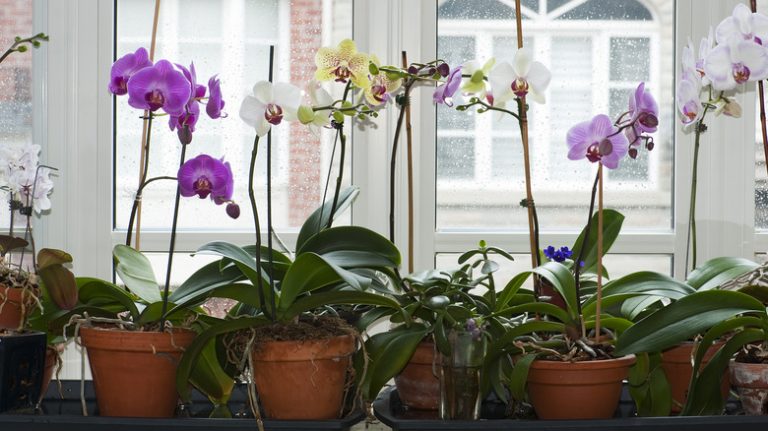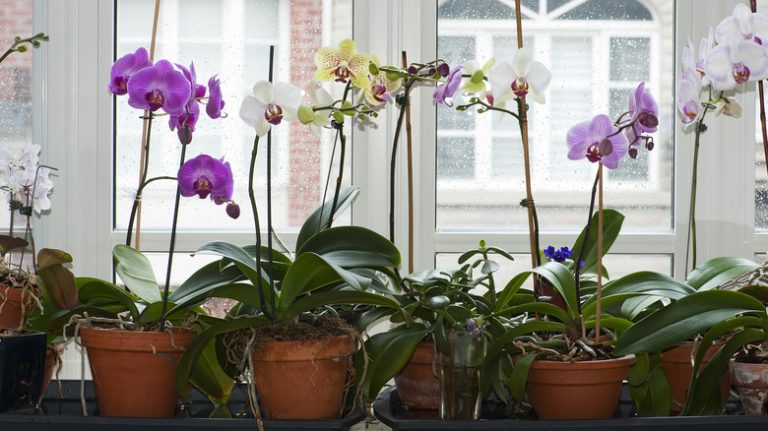Dinnerplate dahlias are a popular choice among floral enthusiasts for their stunning blooms and taller-than-average height. These larger-than-life flowers make a statement in gardens and bouquets alike, with their captivating petals and impressive size. If you’re looking to grow these beautiful flowers in your own garden, this guide will provide you with all the directions and care tips you need to keep your dinnerplate dahlias thriving throughout the season.
When planting dinnerplate dahlias, it’s important to choose the right location. These plants prefer full sun and well-drained soil. If your soil isn’t ideal, you can improve drainage by adding organic matter. Plant the tubers about 6 to 8 inches deep, with the eye facing up. Before transplanting the tubers, always reference the specific planting directions for the variety you’re growing.
Dinnerplate dahlias require regular watering, especially during dry spells. However, it’s important not to overwater them, as they don’t like to sit in overly wet conditions. To maintain the health of your plants, you should also provide them with a balanced fertilizer every few weeks. As the plants grow taller, you may need to stake them to prevent them from toppling over.
When the dahlias start to bloom, it’s time to pick your favorites for arrangements. With their large, show-stopping blooms, dinnerplates are a popular choice for floral arrangements. Using clean, sharp scissors, cut the stem at a 45-degree angle just above a set of leaves. To prolong the life of your arrangements, remove any leaves that would be submerged in water.
There’s a wide variety of dinnerplate dahlias available, each with its own unique color, size, and petal arrangement. Some popular varieties include “Thomas Edison,” a deep purple bloom with a touch of red; “Otto’s Thrill,” a vibrant red with white stripes; and “Sunburst,” a sunny yellow flower with hints of red. Whether you prefer a classic white or a bold striped blossom, there’s a dinnerplate dahlia for everyone.
The history of dinnerplate dahlias can be traced back to the late 1800s. They were first developed in the United States and quickly gained popularity for their immense size and perfect form. Today, these stunning flowers continue to captivate gardeners and customers alike, offering an illusion of perfection that is hard to resist.
Throughout the growing season, it’s important to regularly check your dinnerplate dahlias for any signs of pests or disease. Aphids and slugs can be a common issue, but there are various organic pest control methods you can employ. By staying vigilant and providing proper care, you can enjoy a bountiful harvest of these floral treasures.
So, if you’re ready to add a touch of elegance and drama to your garden, consider growing dinnerplate dahlias. With their massive size and breathtaking beauty, these flowers are sure to turn heads and create a vibrant and colorful oasis. Follow this guide and unleash the full potential of these stunning plants in your own garden.
Dinner Plate Dahlia
The Dinner Plate Dahlia, also known as Dahlia variabilis, is a variety of dahlia that produces large, showy blooms. These flowers are known for their stunning size, often reaching up to 10 inches in diameter. Dinner Plate Dahlias come in a variety of colors and patterns, making them a popular choice for floral arrangements and gardens.
To start growing your own Dinner Plate Dahlias, you can either start from seed or purchase bulbs. If starting from seed, it is best to begin early in the year, as they can take a while to grow and bloom. If using bulbs, plant them in a well-draining location that receives full sun.
Dinner Plate Dahlias are relatively low maintenance and do not require much pruning or fertilizing. However, it is important to provide them with regular watering, particularly during dry periods. They also benefit from a re-cut of the stem at a 45-degree angle before placing them in water.
There are many different cultivars of Dinner Plate Dahlias to choose from, such as the popular ‘Ferncliff Tallulah’ and ‘Edison Tahiti’. These cultivars come in a range of colors, from vibrant oranges and pinks to subtle whites and pastels.
To care for your Dinner Plate Dahlias, it is important to provide them with support as they grow. This can be done by inserting stakes or cages into the ground around the plants. This will help to prevent them from wilting or falling over as they reach their full size.
Dinner Plate Dahlias make a stunning addition to any garden or floral arrangement. Their large, showy blooms are sure to be a centerpiece and a conversation starter. Whether you are a seasoned gardener or just starting out, Dinner Plate Dahlias are a must-have for any flower lover.
To learn more about growing and caring for Dinner Plate Dahlias, check out the directions and tips provided in the links below. You will find step-by-step guides, photos, and reference materials to help you grow these beautiful flowers to perfection.
- How to Grow Dinner Plate Dahlias
- Dinner Plate Dahlia Care Guide
- The History of Dinner Plate Dahlias
- 10 Stunning Dinner Plate Dahlias Varieties
- Using Dinner Plate Dahlias in Floral Arrangements
About
Dinnerplate dahlias are large and showy flowers that can grow to be more than 8 inches in diameter. These stunning flowers are a great addition to any garden, as they’ll add a pop of color and beauty to your space. With their dinnerplate-sized blooms and lush foliage, dinnerplate dahlias are sure to catch the attention of anyone who passes by.
One great variety of dinnerplate dahlias is Otto’s Thrill. This variety, which grows to about 7 feet tall, has salmon-colored flowers that are absolutely gorgeous. Another popular variety is Kelvin Floodlight, which produces double blooms in a vibrant shade of yellow. Dahlia Labyrinth is another stunning variety, with its fully double flowers and beautiful pompom shape.
If you’re looking to start growing dinnerplate dahlias, here are a few tips to get you started. First, choose a sunny location in your garden, as dinnerplate dahlias need at least 6 hours of direct sunlight each day. Make sure the soil is well-draining, as dahlias don’t like to sit in water. Before planting, dig the soil and incorporate some organic matter, like compost, to help improve its fertility.
If you’re starting from bulbs, plant them in the spring after the danger of frost has passed. Make sure to plant them about 1 inch deep and 2 feet apart. If you’re starting from seed, you can begin the process indoors about 6 to 8 weeks before the last expected frost date. Once the seedlings are large enough, you can transplant them into your garden.
As your dinnerplate dahlias start blooming, you’ll want to make sure you’re giving them the right maintenance. Deadheading, which is removing the spent flowers, will help encourage more blooms to appear. You can also pinch back the side shoots to promote bushier growth. If you’re looking to have dahlias for bouquets, you can take cuttings of the flowers. Just make sure to use clean scissors and follow the directions for dividing and arranging the cuttings.
One important thing to know about dinnerplate dahlias is that they are not frost-tolerant. Once the frost hits, the foliage will die back, and you’ll need to dig up the tubers for overwintering. Store them in a cool, dry location until the next growing season.
Overall, dinnerplate dahlias are a beautiful and eye-catching addition to any garden. Whether you’re a seasoned gardener or just starting out, these flowers are sure to bring joy and beauty to your outdoor space.
Customer Care
When it comes to growing dinnerplate dahlias, customer care is an important aspect to consider. Whether you are a beginner or an experienced gardener, there are always new things to learn and earn in the world of dahlias.
Starting with tubers, it is always a good idea to purchase them from a reliable source. Dinnerplate dahlias come in various sizes, and it is important to choose the right size for your garden. Once you have your tubers, plant them in a well-drained and frost-free location. Dinnerplate dahlias prefer full sun, so choose a spot that receives at least 6 to 8 hours of direct sunlight per day.
While planting, make sure to follow the propagation directions that come with the tubers. Some varieties may require different planting depths and spacing. For example, the dinnerplate dahlias ‘Ferncliff Fuchsia’ and ‘Ferncliff Kelvin’ need to be planted 6 inches deep and 2 feet apart.
After planting, it is important to provide proper care to ensure the health and growth of your dahlias. Regular watering is crucial, especially in the early stages of growth. Dahlias do not like to be overwatered, so make sure to water them thoroughly, but allow the soil to dry out between waterings. Applying mulch around the base of the plants can help retain moisture and protect the tubers from extreme temperatures.
As the dahlias grow, you may need to provide support to the stems to prevent them from bending or breaking. Using stakes or cages can help keep the plants upright. Additionally, it is important to monitor for any pests or diseases that may affect your dahlias. Regular inspection and proper management will ensure the health of your plants.
When it comes to pruning dahlias, it is important to know that they are not like other flowering plants. Dahlias do not require extensive pruning like roses or shrubs. However, it is important to remove any dead or damaged stems and flowers. This will promote new growth and ensure that the plant stays healthy and productive throughout the growing season.
If you are looking to grow dahlias on a larger scale, you should pay special attention to customer care. Managing a large-scale dahlia garden requires attention to detail and proper maintenance. From planting to pruning, each step must be done carefully to ensure the best results.
With the right care and attention, your dinnerplate dahlias will grow into beautiful and stunning blooms. The large, fully double flowers with their elegant petals will be a showstopper in your garden. Whether you choose varieties like ‘Penhill Dark Monarch’ with rich purple flowers or ‘Thomas A. Edison’ with deep burgundy blooms, dahlias are sure to impress.
In conclusion, customer care is an essential aspect of growing dinnerplate dahlias. By following proper planting, watering, and pruning techniques, you can ensure the health and beauty of your dahlias. So go ahead and start your dahlia journey, and watch as these stunning flowers become yours to enjoy!

